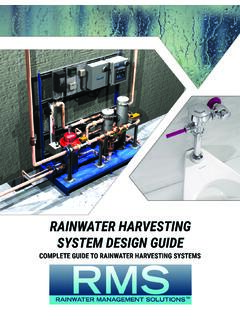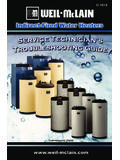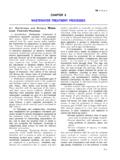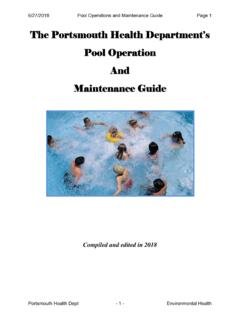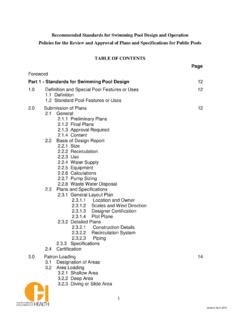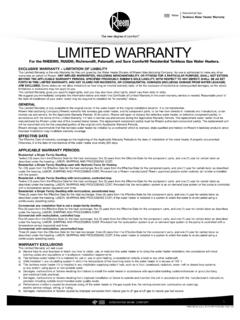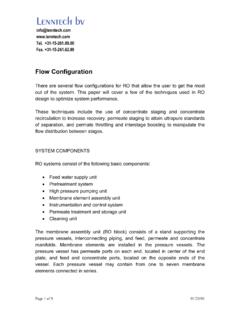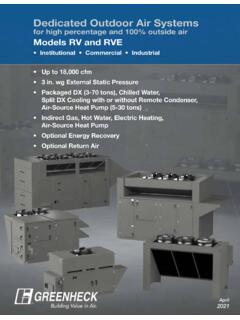Transcription of HIGH PERFORMANCE CLEANROOMS
1 HIGH PERFORMANCECLEANROOMSA Design Guidelines SourcebookJanuary 2006 TABLE OF Air Change Demand Controlled Dual Temperature Chilled Water Exhaust Fan-Filter Low Pressure Drop Air recirculation Air System Vacuum Pump Waterside Free design is a challenging field dominated by the need for high reliability,maintenance of strict space cleanliness requirements, life safety, and narrow temperature and humidity control bands. By necessity, efficiency is a lower priority in design. But there are a number of design approaches that have been shown to meet all the requirements of acleanroom facility robustly while minimizing power consumption and cost.
2 The CleanroomDesign Guidelines describe a number of successful and efficient design practices specificallyappropriate for cleanroom on actual measurement of operating cleanroom facilities and input from cleanroomdesigners, owners and operators, the Cleanroom Design Guidelines offer many successfuldesign approaches that apply to most cleanroom facilities. No single recommendation can beappropriate for every cleanroom facility, but baseline measurement has clearly shown largeefficiency differences between design solutions that support identical cleanroom Design Guidelines are not universal rules, but offer recommendations to the cleanroomdesigner who has little time or budget to evaluate the wide range of efficiency options suitablefor and proven in cleanroom cleanroom design is a relatively mature industrial field.
3 The low emphasis on energy efficiency and a conservative tendency on the part of designers to re-use proven designs regardless of their efficiency (often their efficiency was never measured) still results in needlessly inefficient designs. The Cleanroom Design Guidelines help identify more efficientdesign approaches, allowing at least a high level consideration of efficiency to be included in,and impact, a design process typically compressed by budget and schedule AIR CHANGE RATESR ecirculation air change rates (ACRs) are animportant factor in contamination control in a cleanroom and are the single largest factor in determining fan and motor sizing for a recirculation air handling system.
4 Air handlersizing and air path design directly impacts thecapital costs and configuration of a building. Many air change rate recommendations weredeveloped decades ago with little scientificresearch to back them up. The recommended design ranges for ISO Class 5 (Class 100) cleanroom ACRs are from 250 to 700 air changes per hour (see Figure 2). Higher ACRs equateto higher airflows and more energy use, and don t always achieve the desired cleanliness. Bothnew and existing systems can benefit from optimized air change rates.
5 Frequently this equatesto lower air change has shown that most facilities are operated at or below the low range of recommended ACRs. A Sematech study has also verified that lowered air change rates in CLEANROOMS are adequate in maintaining cleanliness. The actual operating ACRs documentedfor ten ISO Class 5 CLEANROOMS was between 94 and 276 air changes per Lower air change rates result in smaller fans, which reduce both the initial investment andconstruction cost. Fan power is proportional to the cube of air change rates or airflow.
6 A reduction in the airchange rate by 30% results in a power reduction of approximately 66%. Lower airflow may improve the actual cleanliness by minimizing Designers and cleanroom operators have a variety of sources to choose from when looking for ACR recommendations. Recommendations are not based on scientific findings and consequently there is no clear consensus on an optimum ACR. For this reason, many of the established guidelines are are several conflicting sets of recommendations on cleanroom airflow.
7 Articles inCleanrooms magazine1have explored the different ways of measuring or describing airflowand have discussed the Institute of Environmental Sciences and Technology (IEST; RollingMeadows, Ill.) recommendations; however, few industry observers have examined actual practices and the relationship on construction and energy 1 DUCTEDHIGHEFFICIENCYPARTICULATEAIR(HEPA) FILTERSINCLEANROOMINTERSTITIALSPACE4 There is no agreement on a recommended ACR rate. Most sources suggest a range of rates,while these ranges tend to be wide and do not provide clear guidance to designers who need toselect a set ACR value to specify equipment sizes.
8 Figure 1 shows the result of a comparativereview of recommended better air change rate practices will allow designers to lower construction costs as well as reduced energy costs while maintaining the high level of air cleanliness that is required in cleanroom Magazine3pointed out that many of the recommended ACRs are based on relatively low-efficiency filters that were prevalent in the mid 1990 s. For example, today swidely-used percent efficient filters are three times more effective at filtering out particles than the percent filters that were common in the mid 1990 s.
9 Ultra-low penetration air (ULPA) filters are even more efficient than those of the mid 1990 high end of that range is almost three times the rate at the low end, yet the impact of thisdifference on fan sizing and motor horsepower is radically greater. According to the fan affinitylaws, the power difference is close to the cube of the flow or air change rate difference. Forexample, a 50 percent reduction in flow will result in a reduction of power by approximately afactor of eight or percent. Due to filter dynamics, the cube law does not apply exactly and,typically, the reduction is between a cube and a square relatively modest reductions of 10 percent to 20 percent in ACR provide significant benefits.
10 A 20 percent decrease in ACR will enable close to a 50 percent reduction in fan energy savings opportunities are comparable to the potential fan size 2 RECOMMENDEDAIRCHANGERATESFORISO CLASS5 (CLASS100)CLEANROOMS25 ACR reductions may also be possible when CLEANROOMS are unoccupied for a length of time. In most CLEANROOMS , human occupants are the primary source of contamination. Once acleanroom is vacated, lower air changes per hour to maintain cleanliness are possibleallowing for setback of the air handling systems.

